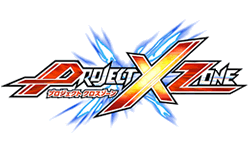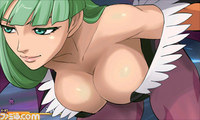|
|

|
PLATFORM
|
3DS
|
BATTLE SYSTEM
|

|
INTERACTION
|

|
ORIGINALITY
|

|
STORY
|

|
MUSIC & SOUND
|

|
VISUALS
|

|
CHALLENGE
|
Moderate
|
LANGUAGE BARRIER
|
Moderate
|
COMPLETION TIME
|
40-60 Hours
|
|
OVERALL

|
+ References more than 30 games.
+ Character graphics are well adapted.
+ Battles are filled with awesome.
+ Soundtrack is very extensive.
- Game progression is super-linear.
|
Click here for scoring definitions
|
|
|
Very few titles could be described as a once in a lifetime experience, as the sort of game that could only come around once in a generation — even a gaming generation. Due to the eclectic nature of its pedigree, Project X Zone is just such a game. Building on the works of three (or four, depending on how you count) game companies spanning twenty-five years of gaming history, PXZ possesses a laundry list of references and inside jokes designed to delight the veteran player but also be playable by the neophyte.
There is an interesting balance to the contributions that various games make. The fighting games provide more heroes and villains on average, with the adventure and RPG titles providing most of the battlegrounds and the monsters therein. Characters from minor titles, like Neneko (Yumeria) and Tron Bonne (Mega Man Legends), have a surprisingly large impact on the progression of the game. The villains from Darkstalkers and Street Fighter IV were apparently brought into the game in the midst of hatching their diabolical plots from those games. It all comes together oddly, but more or less cohesively.
The plot is PXZ's weakest point, while the elements that form it are the game's greatest attraction. With approximately eighty characters — good, bad, or other — and a disparate assortment of locations associated with over twenty games, it's a credit to the writers at Monolith that they managed to keep the story as a coherent as they did. The very basic version is that a group called Ouros Prox has stolen a mysterious stone from its keepers in Tokyo and is using it to bend or break the boundaries of reality. Time, space, and reality warp and merge at odd points, connecting locations that could not or should not be linked. Most of these places have connections to the game's characters, though one of them, the Gain Ground, is a game reference in its own right.
More interesting are the lengths that the writers went to in order to have the characters know each other. Sometimes it's professional courtesy, like between Chun-Li of the international police and the Resident Evil heroes. Sometimes it's respect towards an elder, like the way Arthur from Ghosts n' Goblins is regarded by every monster-hunting character in the game. Often, it's through direct reference to previous crossover titles, such as Namco X Capcom and the Endless Frontier games (which provide their own heroes and villains to the mix). And of course, there's also notoriety; almost everyone seems to know Heihachi Mishima of Tekken early in the game. The best such moment, however, is when Xiao-Mu (from Namco X Capcom) correctly identifies the .//hack heroes because she likes to play The World during office hours instead of working.
 Swords That Smash Evil
Swords That Smash Evil
|
|
It's best not to focus too hard on the plot. Doing so will inevitably lead to all of the game's plot holes agglomerating into one super-massive plot horizon within the player's brain. Thankfully, when faced with the image of Hsien-ko (Darkstalkers), Frank West (Dead Rising), Tron Bonne, Morrigan Ainsland (Darkstalkers), and Chun-Li (Street Fighter) all converging like a storm of kicks, shots, and chainsaws upon a hapless Aragami (Gods Eater), all thoughts of the plot dissolve in the presence of so much awesome.
Just from the screenshots, one might assume that PXZ's gameplay is the lovechild of Super Robot Wars and a beat 'em up fighting title, and that's not too far from the truth. Certainly, the game's progression plays out like an SRW tactical game, fought upon large maps in a linear series of chapters. Whenever an allied unit engages with the enemy, however, the game cuts away to a side-view battle screen. Different combinations of the A button and directional pad trigger different attacks, with the number of actions available increasing over time. There is a limit to the number of attacks the characters can make in one encounter, which is tied to the total number of sets of attacks that unit has. So, if a character pair has four sets available, then they can hit at least four times. The player can opt to simply do the same thing four times straight or use every possible set just once, but gain a fifth attack chance as a bonus. Different combos send the enemy flying in different directions and some are better suited for chaining than others, so it's up to the player to learn the best patterns to ensure the enemy stays up in the air.
 Fire in the hole!
Fire in the hole!
|
|
Like in the Endless Frontier games, enemy juggling is important. Enemies can't block attacks when they're in mid-air, and the total number of hits in a combo string translates into a bonus for the Cross Gauge. Items can bring this gauge up to one hundred percent, but attacks can raise it as high as one hundred fifty. This can be crucial, as a lot of things are fueled by this gauge. Almost all of the special skills learned in this game require a percentage off of it, including skills to extend movement range, raise any or all stats, bring in more support during attacks, heal wounds, cure ailments, or bust through enemy defenses. If a character pair is knocked out, then a large amount of the gauge will be needed to revive them. And of course, super attacks and multi-hit map attacks also take a lot of juice.
Combat tends to be a flurry of animation as the two main members of an allied unit throw everything they've got at the enemy. To add to the chaos nearby units can be called in for support attacks, and solo units (independent characters without a partner) can be assigned to any regular unit, granting non-combat skills and an extra attack in battle. Constant input from the player keeps things timed properly and provides a sense of involvement in proceedings which otherwise might feel too automated.
In the larger picture, the big battle maps can be very involved. Often the primary goal or villain for the chapter won't even be revealed until well after the action has begun, and major surprises and tactical upsets are not uncommon. While item use is free in that it doesn't take any turns or Cross Gauge power, the player is limited to just the items that are dropped by enemies or found in chests, so items remain a tool instead of a crutch to make battles too easy.
The game sprites are all very impressive, especially considering how many of the game's characters come directly from polygonal 3D fighting games or otherwise lack anime-style portrait art in their original formats. The portrait art in PXZ tries hard to stay true to each character's original art, which can lead to some odd discrepancies in style, but overall it works quite well. Every character pair unit and major enemy has his, her, their, or its own special attacks, which are as flashy and as detailed as anyone could ever desire.
 Cleavage is only a small part of this game's service to the fans.
Cleavage is only a small part of this game's service to the fans.
|
|
The game's soundtrack also benefits greatly from the abundance of source material. Just as an example, the soundtrack that came with the game — which by definition is an abridged and incomplete selection of the game's music — was seventy-six minutes long and had forty-four tracks, twelve of which were original to this game. PXZ's auditory impact can obviously be quite varied, but it certainly gets the job done. The voice acting mainly kicks in for the most important scenes of the game, though sound bites can be heard throughout combat. Interestingly, a character's sound bites change up from time to time, so the player doesn't have to listen to the same words shouted over and over again.
Project X Zone has been a wild ride from start to finish at sixty hours to completion. Time just flew by while varied heroes went a-smashing, which is a good testament to how addictive the gameplay can be. While it's not the most difficult of titles, at least in the first playthrough, it does a good job of getting the player into the action. Really, this is an example of Monolith doing what it does best: creating a fan-friendly title with a killer battle system, lots of explosions and fanservice, and very little care as to how much sense it makes in the long run. After all, it's the fun that counts.
Review Archives
|









